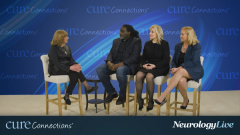
Diagnosis and Management of Multiple Sclerosis Today
Craig Mainor, a patient with multiple sclerosis, shares the story of his diagnosis. The panel discusses the advances in diagnosis and management of multiple sclerosis in the last 30 years.
Episodes in this series

June Halper, MSN, APN-C, MSCN, FAAN: Hello, and thank you for joining this Neurology Live® Cure Connections® program titled “The Patient Journey in Multiple Sclerosis.” I’m your host, June Halper. I’m a nurse practitioner who has specialized in MS [multiple sclerosis] for a long time. I’m the CEO of the Consortium of MS Centers, an organization that has set a unique model of comprehensive MS care. I’m joined by Dr Mary Ann Picone, my wonderful colleague and partner. She’s the medical director of the MS Center at Holy Name Hospital in Teaneck, New Jersey. I’m also joined by Gina Murdoch, the president and CEO of the Multiple Sclerosis Association of America in Cherry Hill, New Jersey. Last but not least, Craig Mainor, a patient and passionate MS advocate and partner who’s going to share his story with us. Thank you all for coming.
Mary Ann Picone, MD: Thank you.
Gina Murdoch: Thank you.
June Halper, MSN, APN-C, MSCN, FAAN: Dr Picone, how are you?
Mary Ann Picone, MD: Great. It’s nice to be part of this. I’m so happy to see you and be here with Craig and Gina.
June Halper, MSN, APN-C, MSCN, FAAN: Tell us, what’s multiple sclerosis? How do we understand it?
Mary Ann Picone, MD: It’s an autoimmune, demyelinating disease. This means that, for reasons we don’t completely understand—although we’re getting a little closer to understanding some of the triggers for MS development—this is when the body starts to recognize parts of itself. These parts are the myelin, the fatty coating that surrounds the nerve fibers in the central nervous system; the brain; and the spinal cord. They produce antibodies against it. There’s inflammation, there’s breakdown of myelin, and also potentially the nerve fiber that the myelin surrounds. When you lose that, there’s decreased conduction of electrical impulses from the brain to different parts of the body. The more myelin that’s lost, the greater disconnection you have.
Everybody with MS is different. Depending on where in the brain or the spinal cord lesions occur—by lesions, we mean those areas where there’s lots of myelin—you can have different symptoms. Patients can have problems with optic neuritis, where there’s blurred vision, difficulty seeing, loss of vision. Others might present with balance problems, gait difficulties, dragging their leg, numbness, tingling. Depending on where in the brain and the spinal cord you have those areas, where there’s a loss of myelin, you have different symptoms.
June Halper, MSN, APN-C, MSCN, FAAN: Craig, how did you experience your MS?
Craig Mainor: Thank you for allowing me to share my story. My journey started in 1993. I was working and I started to feel a loss of dexterity in my left hand. At first I ignored it. As it began to progress and become more defined, I started to get worried and saw a doctor. Originally, the doctors thought it was Lyme disease. I went through some testing, and a short time later, it was determined that I had MS. That was new to me and my family.
June Halper, MSN, APN-C, MSCN, FAAN: You’re lucky because in 1993, they weren’t diagnosing MS that quickly. Diagnosis is happening much more rapidly, right Dr Picone?
Mary Ann Picone, MD: That’s 1 of the big changes throughout the years. We recognize the disease earlier, and there’s more awareness of multiple sclerosis. There have been more treatments available since 1993 to help to decrease flare-ups that patients may have and slow the progression of the disease. We’ve come quite a way.
June Halper, MSN, APN-C, MSCN, FAAN: Gina, you do a lot of services in the community. Have you seen a great change in MS since the ’90s?
Gina Murdoch: Absolutely. First, thank you for being here. It’s a pleasure to be with all of you. There’s so much more information and awareness about multiple sclerosis since the ’90s. There’s more effort to provide programs and services and awareness, for not only the individual living with MS but the entire family unit. Also, it’s important to talk to children whose parents have MS and consider what that does for the family, including care partners. There’s also been a lot of evolution in some of the programs we run, making sure programs are in different languages, and are looking at rural populations and communities of color and how they’re impacted by MS. There’s been, since that time, a real growth in awareness and sensitivity of engagement in how MS impacts different communities and the family. Not only the individual, but everyone supporting that individual around them.
June Halper, MSN, APN-C, MSCN, FAAN: I remember when I started working with MS. Some people didn’t want to tell. They kept it secret because there was no treatment. Craig, how have you been handling it as far as your family and friends? Do you disclose it much? It’s rare for a man to get MS, so a man of color may have a little more of a challenge. How have you handled it?
Craig Mainor: In the beginning, I tried to keep it to myself, because you couldn’t tell from looking at me that there was something wrong. But I knew there was something going on.
June Halper, MSN, APN-C, MSCN, FAAN: Sure.
Craig Mainer: As I’ve gotten more information about the disease—and the hope that came with that information—I’ve told others. “You may not see it, but I have MS and I have these struggles. I have these challenges.” It helps the outside world understand who I am and what path I’m trying to go on.
Transcript edited for clarity
Newsletter
Keep your finger on the pulse of neurology—subscribe to NeurologyLive for expert interviews, new data, and breakthrough treatment updates.


































